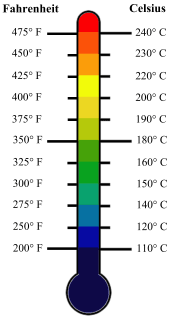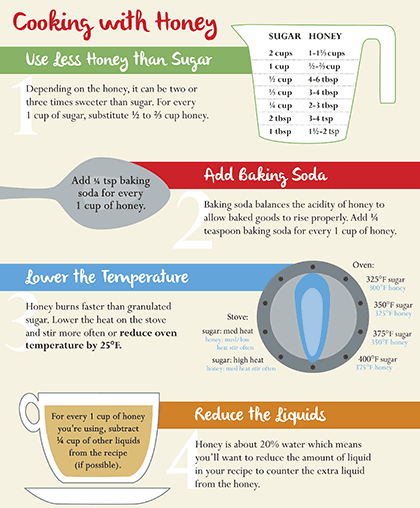How to successfully use honey instead of sugar in your baking
Honey does more than just add earthy sweetness to a recipe, it adds air to baked goods keeping them moist, contributes to browning, and adds chewiness and crispness. And each honey varietal imparts a different flavour to your baking.
But when it comes to using honey in a recipe instead of sugar, it’s not as simple as a one-for-one swap. Honey is sweeter than sugar, so if the incorrect ratio is used, your baking will be too sweet, can have a strange chewy texture, and the cooking time will be different.
But don’t despair. It is actually very easy to substitute honey for sugar in your baking, and the ratios are relatively easy to remember. We have a few simple rules, and a very handy printable chart, to help.
But firstly, when can’t you use honey instead of sugar?
The only time you can’t really swap honey for sugar is when the recipe calls for you to cream the butter and sugar. Basically, for air to be incorporated into the batter, the sugar needs to be lightweight. Granulated sugar crystals have sharp edges that slice the butter, creating air pockets that expand when heated, contributing to a lighter product. The density of honey will keep the air from integrating, weighing your baking down and making a coarser, chewier texture.
Baking with honey – our tips
1. Use less honey than sugar
Being largely fructose, honey is sweeter than refined sugar. Depending on the honey, it can be two or three times sweeter than sugar, so you need to reduce the amount of sweetener when swapping white sugar for honey.
The Rule: For every 1 cup of sugar, replace it with 1/2 to 2/3 cup honey.
2. Reduce the liquids
Since honey is about 20 percent water, you’ll need to reduce the total amount of liquids in your recipe to counter the extra liquid from the honey. Reduce the amount of all the liquids in the recipe by one-quarter. So, for every egg in the recipe, add an additional 2 tablespoons of flour. This will help provide more bulk for the liquids to hold on to during baking.
The Rule: For every 1 cup of honey you’re using, reduce other liquids from the recipe by 1/4 of a cup .
3. Put the acid on
Honey is quite acidic. We don’t normally notice this because it’s sweetness masks it. However, the acidity of the honey interacts with the other ingredients. Baking soda helps balance that acidity to allow the baked good to rise properly. Add ½ teaspoon of baking soda for every cup of honey used. (This addition is not necessary with yeast breads).
The Rule: Add 1/4 teaspoon baking soda for every 1 cup of honey used.
4. Honey’s hot

If your baked goods are too dark or keep burning it may be because your oven is too hot. While honey browns beautifully, the higher sugar content means it caramelizes and therefore burns faster than granulated sugar.
Don’t adjust the cooking time because your product won’t finish cooking in time, reduce the oven temperature by about 10°C or 25°F.
The Rule: Reduce the temperature of the oven by 10°C or 25°F.
Quick checklist for substituting honey for sugar

To sum up, do these four things when adapting your recipes.
• Reduce liquids.
• Balance acidity with baking soda.
• Add extra flour for each egg the recipe calls for.
• Reduce the oven temperature.
Practice makes perfect
If you would like to try substituting honey for sugar, remember to follow all the tips above, and avoid recipes that require butter and sugar to be creamed. Here is an easy, handy recipe you could try for starters.
Muesli cookies
INGREDIENTS
• 1/2 cup butter
• 1/3 cup honey
• 1/2 teaspoon ground cinnamon
• 1/2 teaspoon salt
• 1 teaspoon vanilla extract
• 1 large egg
• 1 cup of rolled oats
• 1/2 cup of dried fruit
• 1/4 cup of chopped nuts and seeds
• 1/2 cup whole wheat flour
• 1/2 teaspoon baking powder
INSTRUCTIONS
1. Preheat the oven to 170°C and line a baking tray.
2. Over medium heat, melt the butter and honey. Remove from the heat and stir in the cinnamon, salt, and vanilla. Once the mixture has cooled a little, quickly beat in the egg. Add the oats, nuts, fruit, flour and baking powder and then stir until combined.
3. Take about 2 heaped tablespoons of the dough, roll into a ball and flatten slightly onto the baking tray. Repeat with the rest of the dough, spacing the flattened balls a couple of cms apart. (They barely spread when baked.)
4. Bake until golden brown underneath, 6 to 8 minutes. Transfer the biscuits to a wire rack to cool, if you can wait.
To find a variety of honeys to boost your baking, find us at an Auckland market or you can buy them online. You can be 100% sure that that the raw honey you’re buying from us is pure: no additives, no dodgy harvesting techniques. We also provide free shipping on orders over $50.00
